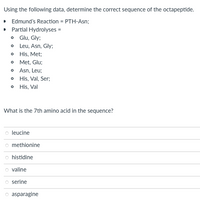
Biochemistry
9th Edition
ISBN: 9781319114671
Author: Lubert Stryer, Jeremy M. Berg, John L. Tymoczko, Gregory J. Gatto Jr.
Publisher: W. H. Freeman
expand_more
expand_more
format_list_bulleted
Concept explainers
Question

Transcribed Image Text:**Determining the Sequence of an Octapeptide**
Given Data for Analysis:
- **Edmund's Reaction**: PTH-Asn
- **Partial Hydrolyses**:
- Glu, Gly
- Leu, Asn, Gly
- His, Met
- Met, Glu
- Asn, Leu
- His, Val, Ser
- His, Val
**Task**: Using the data provided, determine the correct sequence of the octapeptide.
**Question**: What is the 7th amino acid in the sequence?
**Options**:
- Leucine
- Methionine
- Histidine
- Valine
- Serine
- Asparagine
**Explanation of Chemical Processes**:
- **Edmund Degradation**: A method used for sequencing amino acids in peptides. The result of this reaction shows that the N-terminal amino acid is asparagine (Asn).
- **Partial Hydrolysis**: Breaking the peptide bond at several points provides small fragments, which help deduce the sequence.
**Note**: Since graphs or diagrams were not provided, no further detailed explanation of those elements is required.
Expert Solution
This question has been solved!
Explore an expertly crafted, step-by-step solution for a thorough understanding of key concepts.
This is a popular solution
Trending nowThis is a popular solution!
Step by stepSolved in 2 steps

Knowledge Booster
Learn more about
Need a deep-dive on the concept behind this application? Look no further. Learn more about this topic, biochemistry and related others by exploring similar questions and additional content below.Similar questions
- asap plsarrow_forwardDraw the tetrapeptide Met-Ile-Lys-Glu at a ph of 7?arrow_forwardConsider the peptide Trp-Arg-Glu-Cys-Gly-Tyr. For the drawings requested below, please show them in zig-zag style, from amino to carboxy terminus, with correct stereochemistry Draw the predominant form at pH = 2 Draw the predominant form at pH = 5 Draw the predominant form at pH = 7 Draw the predominant form at pH = 12arrow_forward
- a. Suppose that you have the peptide Ala-Gly-Tyr-His-Leu and you treat it with FDNB and then 6M HCl. Draw the structures of all the products that you will have in solution (assume all reactions to go to completion).arrow_forwardThe last residue of the protein (tail) is Tryptophan, and the first residue (head) is labeled with IAEDANS acceptor. Estimate the length of the protein (head to tail) if the efficiency of RET measures at 0.01 Please show step by step and how to get the 34.014 numberarrow_forwardThe biosynthetic pathway for the two amino acides E and H is shown schematically in the Figure below: A W E 2 Z H How would this pathway change if C was mutated and non-functional?arrow_forward
- Determine the sequence of the following 10-mer of ferritin using the data below. i. Complete acid hydrolysis of the 10-mer results in identification of 1A, 1D, 1E, 1F, 1H, 1K, 2L, 1T, 1Y ii. Digestion of the 10-mer with chymotrypsin results in 3 fragments containing (D, H, K, T), (F, L) and (A, E, L, Y) iii. Digestion of the 10-mer with V8 protease, which cuts on the C-side of acidic amino acids, results in three fragments containing (D, F, L, Y), (A, E, L) and (H, K, T) iv. Digestion with trypsin results in a fragment H-T and a fragment with all the other amino acids v. Treatment of the 10-mer with FDNB followed by complete acid hydrolysis results in the following two derivatives, DNP-1 and DNP-2 vi. Treatment of the 10-mer with a carboxypeptidase results in a free threoninearrow_forwardBased on the pK, table for amino acids (Table 1.1), draw the structures with net charge, and the equilibria representing the complete deprotonation of aspartate. Table 1.1 Name pK pk2 pKR Glycine Alanine 2.4 9.8 2.3 9.7 Valine 2.3 2.4 9.6 Leucine 9.6 Isoleucine 2.4 9.7 Methionine 2.3 9.2 Phenylalanine Proline Serine 1.8 9.1 2.0 10.6 2.1 9.2 Threonine 2.6 10.4 Cysteine Asparagine Glutamine 1.8 10.8 8.3 2.0 8.8 2.2 9.1 Tyrosine Tryptophan Aspartate Glutamate 2.2 9.1 10.9 2.4 9.4 2.0 2.2 10.0 3.9 9.7 4.3 Histidine 1.8 9.2 6.0 10.8 Lysine Arginine 2.2 9.2 1.8 9.0 12.5arrow_forward6 (a) A decapeptide has the following amino acid composition: Ala2 , Arg, Cys, Glu, Gly, Leu, Lys, Phe, Val Partial hydrolysis yields the following tripeptides: Cys-Glu-Leu + Gly-Arg-Cys + Leu-Ala-Ala+ Lys-Val-Phe + Val-Phe-Gly. Reaction of the decapeptide with 2,4-dinitrofluorobenzene yields 2,4-dinitrophenylysine. From the experimental data, deduce the primary structure of the decapeptide. (b) Suggest a scheme you will follow to synthesize the dipeptide Ala-Glyarrow_forward
arrow_back_ios
arrow_forward_ios
Recommended textbooks for you
 BiochemistryBiochemistryISBN:9781319114671Author:Lubert Stryer, Jeremy M. Berg, John L. Tymoczko, Gregory J. Gatto Jr.Publisher:W. H. Freeman
BiochemistryBiochemistryISBN:9781319114671Author:Lubert Stryer, Jeremy M. Berg, John L. Tymoczko, Gregory J. Gatto Jr.Publisher:W. H. Freeman Lehninger Principles of BiochemistryBiochemistryISBN:9781464126116Author:David L. Nelson, Michael M. CoxPublisher:W. H. Freeman
Lehninger Principles of BiochemistryBiochemistryISBN:9781464126116Author:David L. Nelson, Michael M. CoxPublisher:W. H. Freeman Fundamentals of Biochemistry: Life at the Molecul...BiochemistryISBN:9781118918401Author:Donald Voet, Judith G. Voet, Charlotte W. PrattPublisher:WILEY
Fundamentals of Biochemistry: Life at the Molecul...BiochemistryISBN:9781118918401Author:Donald Voet, Judith G. Voet, Charlotte W. PrattPublisher:WILEY BiochemistryBiochemistryISBN:9781305961135Author:Mary K. Campbell, Shawn O. Farrell, Owen M. McDougalPublisher:Cengage Learning
BiochemistryBiochemistryISBN:9781305961135Author:Mary K. Campbell, Shawn O. Farrell, Owen M. McDougalPublisher:Cengage Learning BiochemistryBiochemistryISBN:9781305577206Author:Reginald H. Garrett, Charles M. GrishamPublisher:Cengage Learning
BiochemistryBiochemistryISBN:9781305577206Author:Reginald H. Garrett, Charles M. GrishamPublisher:Cengage Learning Fundamentals of General, Organic, and Biological ...BiochemistryISBN:9780134015187Author:John E. McMurry, David S. Ballantine, Carl A. Hoeger, Virginia E. PetersonPublisher:PEARSON
Fundamentals of General, Organic, and Biological ...BiochemistryISBN:9780134015187Author:John E. McMurry, David S. Ballantine, Carl A. Hoeger, Virginia E. PetersonPublisher:PEARSON

Biochemistry
Biochemistry
ISBN:9781319114671
Author:Lubert Stryer, Jeremy M. Berg, John L. Tymoczko, Gregory J. Gatto Jr.
Publisher:W. H. Freeman

Lehninger Principles of Biochemistry
Biochemistry
ISBN:9781464126116
Author:David L. Nelson, Michael M. Cox
Publisher:W. H. Freeman

Fundamentals of Biochemistry: Life at the Molecul...
Biochemistry
ISBN:9781118918401
Author:Donald Voet, Judith G. Voet, Charlotte W. Pratt
Publisher:WILEY

Biochemistry
Biochemistry
ISBN:9781305961135
Author:Mary K. Campbell, Shawn O. Farrell, Owen M. McDougal
Publisher:Cengage Learning

Biochemistry
Biochemistry
ISBN:9781305577206
Author:Reginald H. Garrett, Charles M. Grisham
Publisher:Cengage Learning

Fundamentals of General, Organic, and Biological ...
Biochemistry
ISBN:9780134015187
Author:John E. McMurry, David S. Ballantine, Carl A. Hoeger, Virginia E. Peterson
Publisher:PEARSON